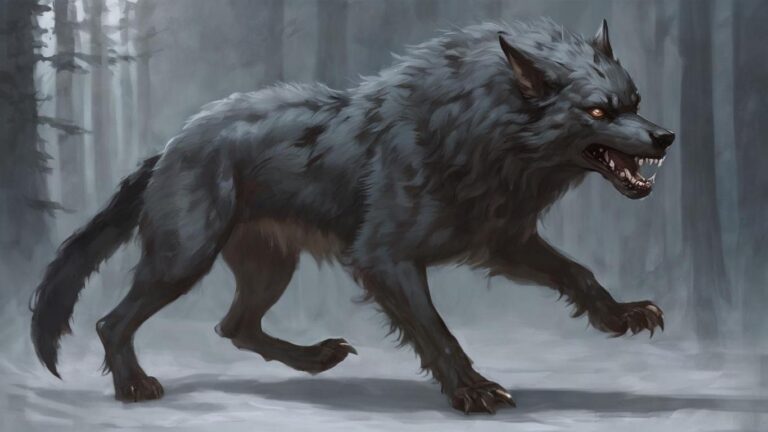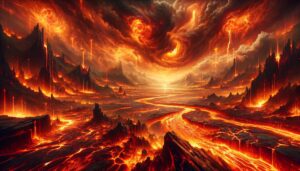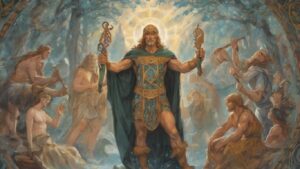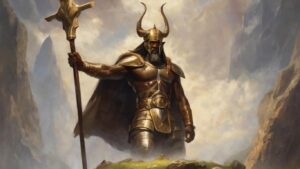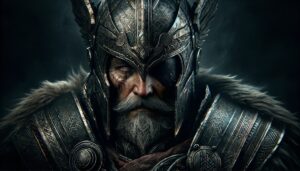Table of Contents
In the rich tapestry of Norse mythology, Fenrir stands as a formidable and enigmatic figure. Known as the monstrous wolf, Fenrir plays a pivotal role in the intricate web of divine narratives. This article delves into the myths surrounding Fenrir, exploring his origins, significance, and the profound impact he has on the Norse cosmos.
Origins and Parentage:
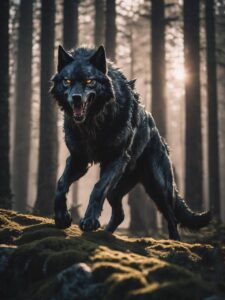
The Growth of a Monstrous Force:
As Fenrir, the monstrous wolf of Norse mythology, grows, so does the palpable tension in the divine realms. His burgeoning strength and ferocity become the focal point of both awe and trepidation among the gods. The prophetic whispers surrounding Fenrir’s growth foretell of a force that will challenge the very foundations of the cosmos.
The gods, recognizing the imminent threat, attempt to contain Fenrir’s escalating power. However, every restraint proves futile in the face of the wolf’s relentless growth. Fenrir becomes a symbol of untamed chaos, a force that eludes the control of the divine pantheon.
The struggle to curb Fenrir’s ascent mirrors the gods’ realization that they are contending with a power beyond their conventional measures. Each attempt to confine the monstrous force only serves to underscore the inevitability of Ragnarök, the apocalyptic event on the horizon.
Fenrir’s growth is not solely physical but also symbolic, representing the swelling tide of chaos that will ultimately engulf the ordered realms of Asgard. The gods, bound by their own decrees and prophecies, find themselves entangled in a complex dance with destiny, where the relentless growth of Fenrir becomes an inescapable element.
The monstrous force that Fenrir embodies is not confined to the physical realm. It extends to the metaphysical, becoming a metaphor for the unraveling of established norms and the encroachment of an uncontrollable power. As Fenrir matures, so does the foreboding atmosphere, setting the stage for a confrontation that will reshape the very fabric of the Norse cosmos.
In the relentless growth of Fenrir, there is an ominous undercurrent—a force that defies restraint, foreshadowing the impending chaos that will mark the climax of Norse mythology’s cosmic narrative.
The Binding of Fenrir:
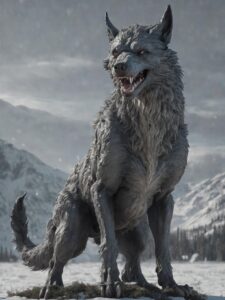
Fenrir and Ragnarök:
Fenrir, the monstrous wolf, plays a pivotal role in the apocalyptic event known as Ragnarök—a cataclysmic climax in Norse cosmology. Foretold by prophecies, Ragnarök is the prophesied end of the world, leading to the demise and rebirth of the cosmos. Fenrir’s fate is intricately woven into this cosmic drama, making him a central figure in the unfolding end times.
In the lead-up to Ragnarök, Fenrir’s binding becomes crucial. The gods, recognizing the imminent threat, restrain him with Gleipnir, averting immediate disaster. This act serves as a catalyst for the events leading to Ragnarök.
As Ragnarök approaches, Fenrir, bound but not subdued, breaks free. The unleashed wolf becomes a force of unparalleled chaos, symbolizing nature’s unrestrained power and defying the order imposed by the gods.
Fenrir’s role in Ragnarök includes a fierce encounter with Odin, the Allfather. The two adversaries engage in a fatal battle, resulting in Odin’s demise. This clash underscores the inevitability of fate and the inescapable cycle of destruction and renewal woven into the fabric of Norse cosmogony.
Propelled by Fenrir, Ragnarök devastates the cosmos. Chaos reigns, gods perish, yet from destruction emerges a new world—Norse cyclical nature. Fenrir’s association embodies profound themes of fate, inevitability, and the perpetual cycle defining Norse cosmology.
Symbolism and Interpretations:
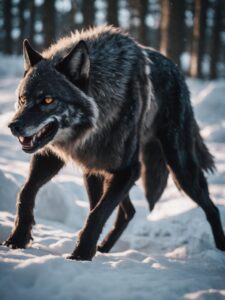
Fenrir, the monstrous wolf of Norse mythology, transcends his role as a mere harbinger of chaos, embodying profound symbolism that invites diverse interpretations. His portrayal as a chaotic force reflects the unpredictable and uncontrollable elements of nature. Fenrir’s ominous presence in the Norse pantheon symbolizes the inevitability of chaos that confronts established orders.
Some interpretations see Fenrir as a representation of the cyclical nature of existence. His binding, release, and involvement in Ragnarök become metaphors for the perpetual cycle of creation, destruction, and rebirth—a theme deeply ingrained in Norse cosmology. Fenrir’s unrestrained power mirrors the forces of nature that elude human control.
In a broader sense, Fenrir’s symbolism extends to the theme of defiance against fate. His resistance to being bound reflects an innate desire to challenge the predetermined course of events, suggesting a nuanced narrative of agency and rebellion. Fenrir becomes a symbol of forces that resist submission to divine will, embodying the complex relationship between fate and free will.
Additionally, Fenrir’s dual heritage as the offspring of Loki and the giantess Angrboða adds layers to his symbolism. As a bridge between the divine and the primal, Fenrir represents the interconnectedness of disparate realms. His existence blurs the boundaries between order and chaos, divinity and primal forces, inviting contemplation on the intricate balance within the cosmos.
Interpreting Fenrir’s symbolism is subjective, influenced by cultural, historical, and individual perspectives. Whether seen as a metaphor for nature’s uncontrollable forces, a symbol of cyclical existence, or an agent of defiance, Fenrir’s significance remains a captivating aspect of Norse mythology.
Legacy in Popular Culture:
Fenrir, the monstrous wolf of Norse mythology, extends his legacy far beyond the ancient sagas, leaving an indelible mark on popular culture. From literature to films, video games to art, Fenrir’s formidable presence resonates across diverse mediums, captivating audiences and inspiring creators.
In literature, Fenrir’s ominous aura has found a place in modern fantasy works. Authors draw upon the wolf’s symbolism of chaos and untamed power, incorporating these elements into narratives that explore the complexities of nature, fate, and the struggle against overwhelming forces. The resonance of Fenrir’s legacy persists in characters and plots that echo the primordial themes of Norse mythology.
In cinema, Fenrir’s monstrous form captivates with ferocity. His film appearances serve as a visual spectacle, embodying primal chaos that adds depth to storytelling.
Artists interpret Fenrir in paintings, sculptures, and illustrations. This breathes life into the ancient myth, offering new perspectives on Fenrir’s legacy.
In popular culture, Fenrir’s legacy is a testament to Norse mythology’s enduring power. Whether a symbol of chaos, a formidable force, or a creature challenging reality, Fenrir resonates across time and mediums. His legacy evolves and thrives in the creative imaginations of storytellers and artists worldwide.
FAQ
Is Fenrir Loki's Brother?
Yes, Fenrir is one of Loki's offspring. He is Loki's son, born of the giantess Angrboða.
Is Fenrir good or bad?
In Norse mythology, Fenrir is often portrayed as a force of chaos and destruction, and his role is generally perceived as malevolent.
Why did Odin hate Fenrir?
Odin did not hate Fenrir, but he foresaw that Fenrir posed a significant threat to the gods. Fearful of the wolf's power, Odin sought to bind Fenrir, leading to events foretold in Ragnarök.
What is Fenrir to Loki?
Fenrir is Loki's son, born from Loki's union with the giantess Angrboða. Their relationship is part of the complex familial dynamics in Norse mythology.
Did Fenrir eat Odin?
In the Norse myth of Ragnarök, Fenrir swallows Odin during the apocalyptic events. This is a symbolic representation of the end of the world.
Why did Fenrir bite Tyr?
Fenrir bit off Tyr's hand during the binding ceremony. Tyr, the god of law and justice, willingly sacrificed his hand to bind Fenrir and fulfill a prophecy.
Why didn't Loki help Fenrir?
Loki, foreseeing Ragnarök and Fenrir's role in it, may have had conflicting emotions. However, Loki did not actively intervene to help Fenrir during the events leading to Ragnarök.
